Introduction
Activities
Publications & Research
Technical Guidelines & Resources
SOPs/Protocols & Important Links
IEC Material
Unit/Laboratories
Poison Information Centers
Partners Resources
Contact Us
Introduction
About NBPCT Programme:
As the designated nodal agency for chemical surveillance, the National Centre for Disease Control (NCDC), Ministry of Health and Family Welfare, Government of India, is in the process of initiating the National Biomonitoring Programme for Chemical Toxicants.
This programme is in line with India’s strategic effort to strengthen chemical risk management and global commitments, obligations and frameworks, including:
- The International Health Regulations (IHR 2005), which call for core public health capacities to detect, assess, and respond to chemical events;
- The Global Framework on Chemicals (GFC) beyond 2020, particularly contributing to Targets A1, A6, B5, and B7 on health, risk reduction, exposure prevention, and surveillance;
- The Stockholm, Minamata, and Basel Conventions, which guide global action on persistent toxicants, mercury, and waste management.
Key Strategic priorities of the programme are:
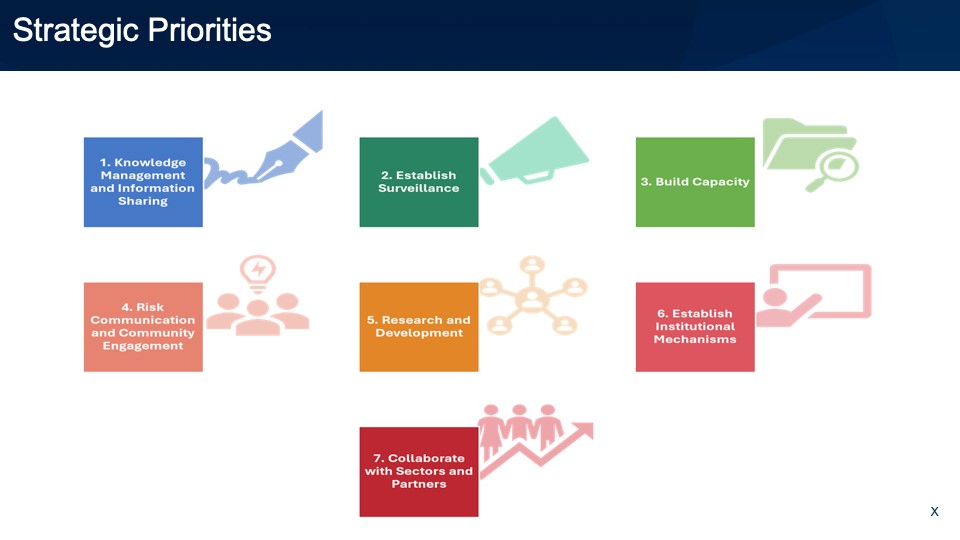
By adhering to global best practices and fostering partnerships across sectors—environment, health, industry, and academia—the programme intends to inform evidence-based public health policy, particularly for high-risk and vulnerable populations.
Progress so far
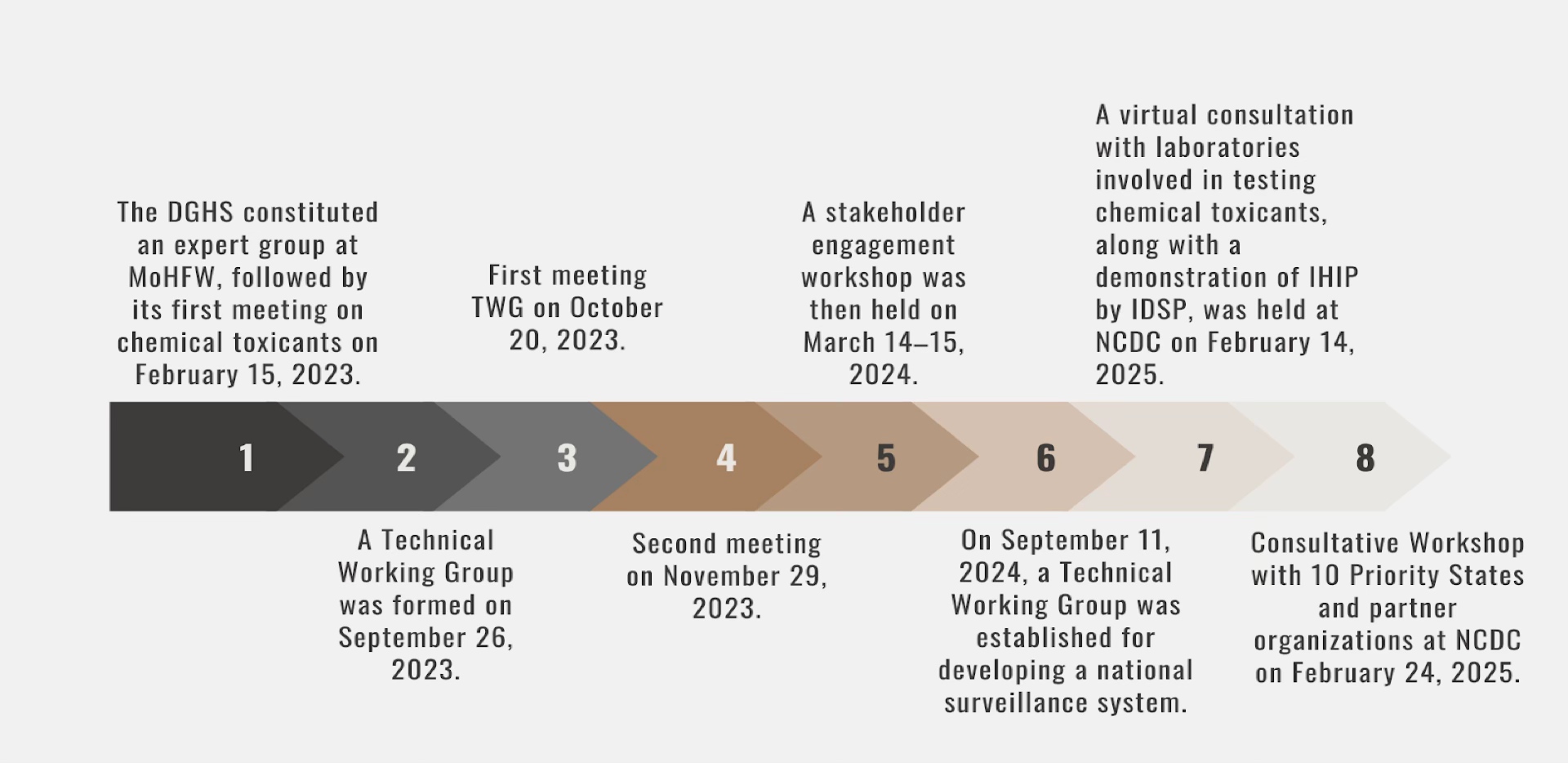
- Ist National stakeholder engagement workshop, March 14-15, 2024
- 2nd National level consultative workshop with 10 priority states and partner organisations, February 24, 2025
- CD Alert on Lead
- List of Poison Information Centres
- Labs with Heavy Metal Testing: As part of this programme, a nationwide mapping exercise is underway to assess regional and national laboratory capacities for testing human and environmental samples for chemical toxicants.If your laboratory has the capacity to conduct such testing, you are kindly requested to submit your details through the Google Form link provided below: https://docs.google.com/forms/d/e/1FAIpQLSeQ46sA5XVOo3Tk-xxhjdN9Qb_tC_LSHBUNXWLSEtLEbPasag/viewform
- PowerPoint Presentation on National Biomonitoring Programme for Chemical Toxicants
Laboratories mapped across India with the capacity to test for chemical toxicants
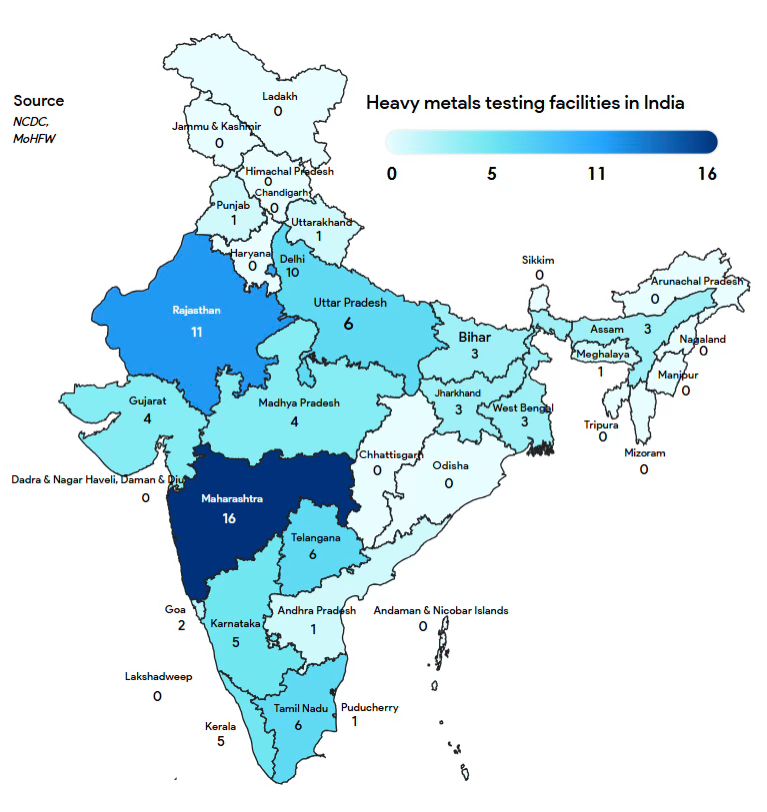
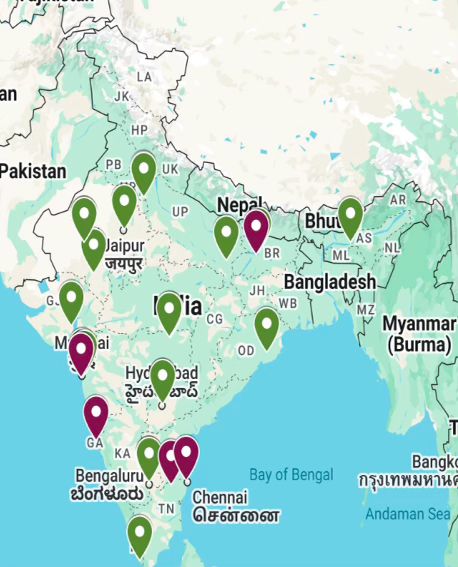
National Biomonitoring Programme for Chemical Toxicants IHIP Learning Portal Link : https://ihiplearning.in/bpct/#/home-page
- Field user: Field investigators will be assigned a unique user ID and login credentials to access the NBPCT module on IHIP. They will be responsible for entering demographic, biological, and source exposure-related data. Between the biological and source exposure data user can click yes for both or either in case only one type (either biological or only source data). Post-primary screening, if biological or environmental samples are collected and further sent to labs for analysis, the investigator can designate the appropriate laboratory from the list of mapped labs and can mark labs to further add data in the same for directly. All mapped labs will have a unique user id and password to further add data in the lab interface.
- Lab user: Lab users will enter chemical analysis results of biological or environmental or both samples collected from the field.
- The State and Centre user interface allows the State and Centre users to view the data and take further actions.
To request for login id and password to access the NBPCT portal, kindly send a request to biomonitoringindia@gmail.com
Activities
Activities
- The DGHS constituted an expert group at MoHFW, followed by its first meeting on chemical toxicants on February 15, 2023.
- A Technical Working Group was formed on September 26, 2023.
- First meeting TWG on October 20, 2023.
- Second meeting on November 29, 2023.
- A stakeholder engagement workshop was then held on March 14–15, 2024.
- On September 11, 2024, a Technical Working Group was established for developing a national surveillance system.
- A virtual consultation with laboratories involved in testing chemical toxicants, along with a demonstration of IHIP by IDSP, was held at NCDC on February 14, 2025.
- Consultative Workshop with 10 Priority States and partner organizations at NCDC on February 24, 2025.
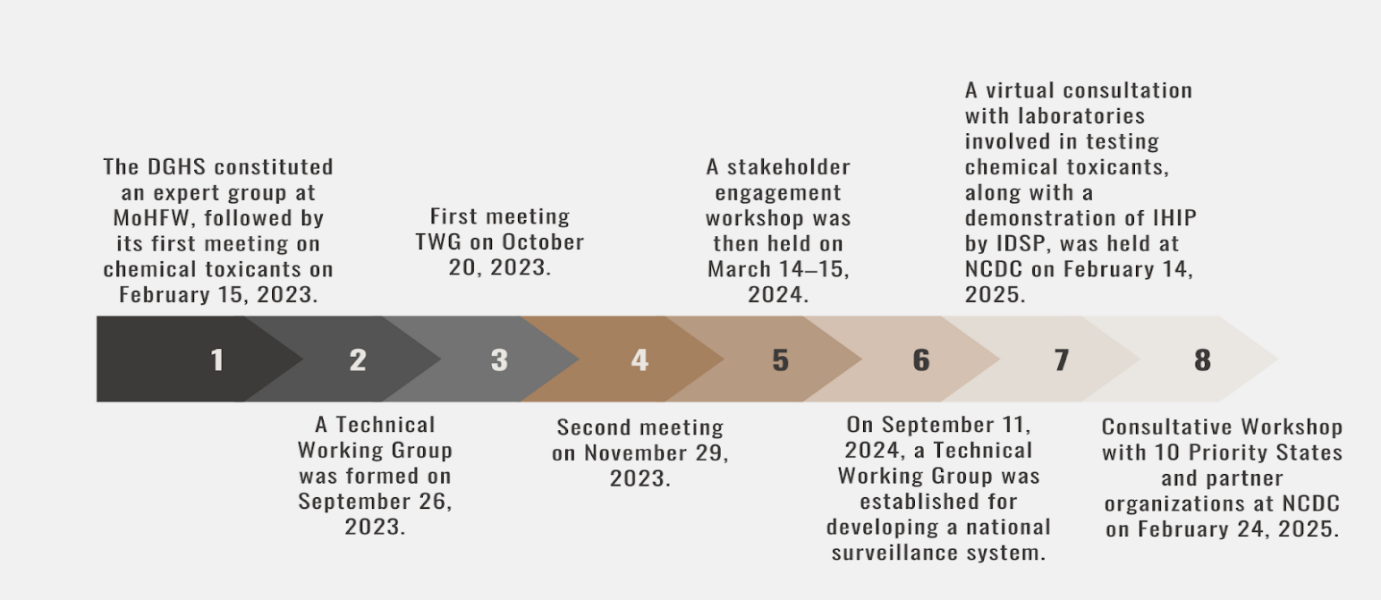
- Chemical Toxicants testing capacity assessment and laboratory mapping- ongoing (through Google Form)
- Virtual consultation with labs done once on Feb 14th, 2025
- First stakeholder workshop held in March 2024 with participation from ministries, medical colleges, and NGOs and led to formulation of 7 action tracks with multiple short, medium, and long-term activities under each action track
- Webpage being developed on IHIP as knowledge resource and for data compilation- State-level studies and researchers encouraged to share data as excel sheets and directly on IHIP once it goes live
- Second Consultative working on NBPCT held on 24th of February 2025- 10 states participated and shared details about the work done in each state.
National Biomonitoring Programme for Chemical Toxicants module on IHIP-For Data collection and capacity building
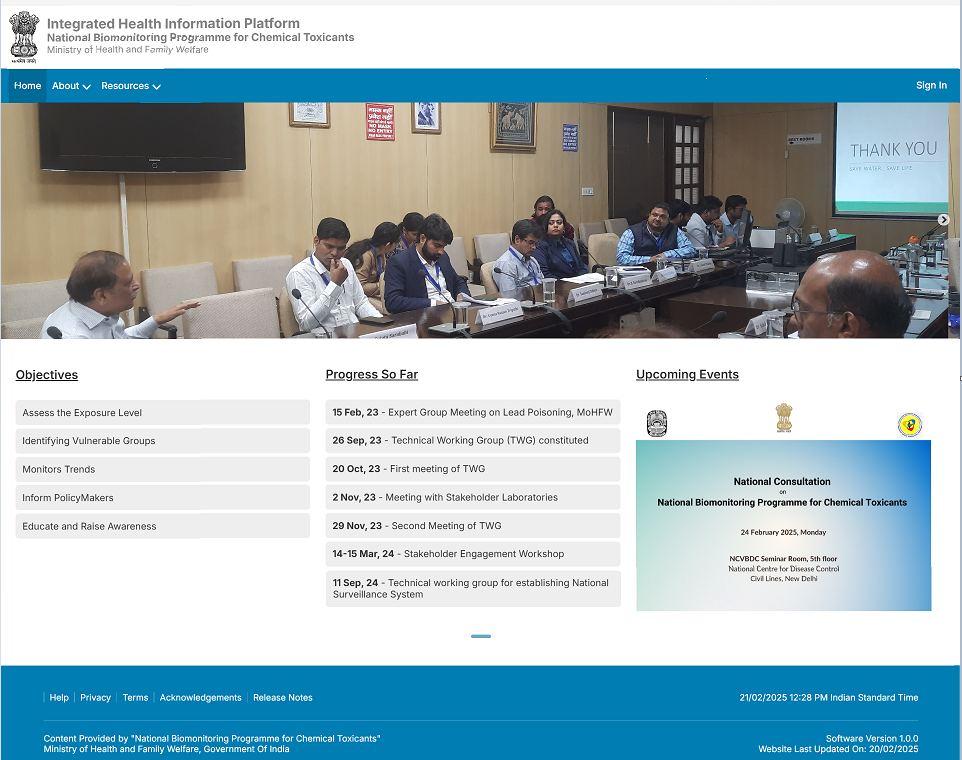
Publications & Research
Publications & Research
National Biomonitoring Programme for Chemical Toxicants (14-15 March 2024)Technical Guidelines & Resources
Technical Guidelines & Resources
Important Acts and Rules
- The Food Safety and Standards Act, 2006
- The Food Safety and Standards Rules, 2011
- The Environment (Protection) Act, 1986, amended 1991
- The Environment (Protection) Rules, 1986
- Hazardous and other Wastes (Management & Transboundary Movement) Rules, 2016
- Bio-Medical Waste Management Rules, 2016
- E-Waste Rules 2016
- Battery Waste Management Rules, 2022
- Solid Waste Management Rules, 2016
- The Water (Prevention and Control of Pollution) Act, 1974
- The Water (Prevention and Control of Pollution) Cess Act, 1977
- The Air (Prevention and Control of Pollution) Act 1981, amended 1987
SOPs/Protocols & Important Links
SOPs/Protocols
- Guideline for clinical management of exposure to lead
- Brief guide to analytical methods for measuring lead in blood
- International Code of Conduct on Pesticide Management: guidance for aerial application of pesticides
- Update on the global status of legal limits for lead in paint, March 2023
- Guidance for Laboratory Biomonitoring Program – Developing Biomonitoring Capabilities
- Assessing Changes in Blood Lead Levels: Study Design Considerations
- Considerations for Planning Childhood Blood Lead Surveillance
- Rapid Market Screening Sampling Protocol
- Home-Based Assessment Protocol
- Toxic Sites Identification Program (TSIP) Investigator Handbook
- Metal Cookware Leaching Test Protocol
- Protocol for Testing Metal Cookware for Lead and Other Heavy Metals
- Guide for Lead-Adulterated Spice Identification and Tracking
- Food Chain Analysis for Lead and Mercury Protocol
Important Links:
- Ministry of Health and Family Welfare, Government of India
- Ministry of Environment, Forest and Climate Change
- CPCB | Central Pollution Control Board
- Indian Council of Medical Research
- WHO – Chemical Safety
- National Institute of Health and Family Welfare
- National Health Systems Resource Centre
- The Food Safety and Standards Authority of India (FSSAI)
- Spices Board of India, Ministry of Commerce and Industry
IEC Material
Unit/Laboratories
Poison Information Centers
List of Poison Information Centers:
| Sl. No. | Latitude | Longitude | Institution Name | Govt/Non-Govt | District | State | Contact Details |
| 1 | 12.9352 | 79.146 | Christian Medical College Hospital, Vellore | Governmental | Vellore | Tamil Nadu | Website |
| 2 | 11.4064 | 76.6932 | JSS College of Pharmacy, Ooty | Governmental | Ooty | Tamil Nadu | Website |
| 3 | 11.9416 | 79.8083 | JIPMER Drug Information Center, Pondicherry | Governmental | Puducherry | Puducherry | Website |
| 4 | 13.0827 | 80.2707 | Pharma Information Center, Chennai | Governmental | Chennai | Tamil Nadu | Website |
| 5 | 13.0827 | 80.2707 | Poison Control, Training, and Research Center, Government General Hospital, Chennai | Governmental | Chennai | Tamil Nadu | Website |
| 6 | 13.0827 | 80.2707 | Sri Ramachandra Hospital, Chennai | Governmental | Chennai | Tamil Nadu | Website |
| 7 | 11.0168 | 76.9558 | Sri Ramakrishna Mission Hospital, Coimbatore | Governmental | Coimbatore | Tamil Nadu | Website |
| 8 | 13.0827 | 80.2707 | Toxicology and IMCU Unit, Government General Hospital, Chennai | Governmental | Chennai | Tamil Nadu | Website |
| 9 | 14.6819 | 77.597 | RIPER Poison and Drug Information Center, RDT Hospital, Bathalapalli | Governmental | Bathalapalli | Andhra Pradesh | Website |
| 10 | 8.5241 | 76.9366 | Alcohol and Drug Information Center (ADIC), Trivandrum | Governmental | Thiruvananthapuram | Kerala | Website |
| 11 | 9.9312 | 76.2673 | Poison Control Center, Amrita Institute of Medical Sciences, Cochin | Governmental | Kochi | Kerala | Website |
| 12 | 8.5241 | 76.9366 | Trivandrum Medical College, Trivandrum | Governmental | Thiruvananthapuram | Kerala | Website |
| 13 | 12.9716 | 77.5946 | Bowring and Lady Curzon Hospital, Bangalore | Governmental | Bangalore | Karnataka | Website |
| 14 | 12.2958 | 76.6394 | JSS College of Pharmacy, Mysore | Governmental | Mysore | Karnataka | Website |
| 15 | 12.9716 | 77.5946 | Drug Information Center (KSPC), Bowring and Lady Curzon Hospital, Bangalore | Governmental | Bangalore | Karnataka | Website |
| 16 | 12.9716 | 77.5946 | Drug Information Center (KSPC), Victoria Hospital, Bangalore | Governmental | Bangalore | Karnataka | Website |
| 17 | 15.8497 | 74.4977 | Jawaharlal Nehru Medical College Hospital (JNMC), Belgaum | Governmental | Belgaum | Karnataka | Website |
| 18 | 13.354 | 74.785 | Kasturba Medical College (KMC), Manipal | Governmental | Manipal | Karnataka | Website |
| 19 | 12.9716 | 77.5946 | Kempagowda Institute of Medical Sciences (KIMS), Bangalore | Governmental | Bangalore | Karnataka | Website |
| 20 | 12.9716 | 77.5946 | KSPC, Bangalore | Governmental | Bangalore | Karnataka | Website |
| 21 | 22.5726 | 88.3639 | Bulletin on Drug and Health Information (BIDI), Kolkata | Governmental | Kolkata | West Bengal | Website |
| 22 | 22.5726 | 88.3639 | CDMU Documentation Center, Calcutta | Governmental | Kolkata | West Bengal | Website |
| 23 | 22.5726 | 88.3639 | N.R.S. Medical College and Hospital, Calcutta | Governmental | Kolkata | West Bengal | Website |
| 24 | 22.5726 | 88.3639 | Poison Information Centre, R.G. Kar Medical College, Kolkata | Governmental | Kolkata | West Bengal | Website |
| 25 | 30.7333 | 76.7794 | Department of Pharmacy Practice, NIPER, Chandigarh | Governmental | Chandigarh | Chandigarh | Website |
| 26 | 28.6139 | 77.209 | National Poisons Information Centre (NPIC), AIIMS, New Delhi | Governmental | New Delhi | Delhi | Toll-Free: 1800 116 117; Tel: 011-26589391 / 26593677; Website |
| 27 | 23.0225 | 72.5714 | Poison Information Center, ICMR-National Institute of Occupational Health, Ahmedabad | Governmental | Ahmedabad | Gujarat | Website |
| 28 | 23.2599 | 77.4126 | Poison Information Centre, AIIMS Bhopal, Madhya Pradesh | Governmental | Bhopal | Madhya Pradesh | Website |
| 29 | 19.076 | 72.8777 | Drug and Poison Information Center (DPIC), P. D. Hinduja Hospital, Mumbai | Non-Governmental | Mumbai | Maharashtra | Tel: 022-2446 4600; Website |
Partners Resources
State-level Initiatives:
| Sl. No. | State-level initiative | Stakeholders |
| 1. | Tamil Nadu presented the methodology and preliminary findings of its statewide study on Blood Lead Levels (BLLs) among children (1-6 years) and pregnant women across seven districts using capillary blood testing. The study identified key exposure sources, including industrial emissions, contaminated consumer products, and household environments, using home-based assessments. | Directorate of Public Health, SRIHER, Vital Strategies, Pure Earth, UNICEF. |
| 2. | Bihar undertook a large-scale surveillance study across eight districts. Findings revealed that 90% of children tested had BLLs exceeding the safe limit, with turmeric contamination being a critical concern. The state identified challenges such as limited laboratory capacity and lack of public awareness, underscoring the need for expanded testing infrastructure, stricter consumer product regulations, and targeted public health campaigns. | Directorate of Health and Family Welfare, Bihar, Mahaveer Cancer Sansthan, Vital Strategies, Pure Earth, UNICEF. |
| 3. | Jharkhand has adopted a Convergent Action Model linking health, environment, and industry departments and has formed a State Task Force (STF) with Rajendra Institute of Medical Sciences, Ranchi (RIMS Ranchi), acting as secretariat. Priorities include improving intersectoral coordination, expanding environmental surveillance, improving enforcement of regulations, and strengthening laboratory capabilities. | Directorate of Health and Family Welfare, Jharkhand, RIMS Ranchi, USAID, IPE Global, Pure Earth, UNICEF. |
| 4. | Uttar Pradesh outlined its multi-pronged strategy for addressing chemical toxicants. Key efforts include youth engagement initiatives, collaboration with professional bodies, interdepartmental coordination using existing platforms, and evidence-generation activities. The state aims to complete a comprehensive assessment of lead exposure across the state by September 2025, leading to policy and regulatory recommendations by year-end. | Department of Health and Family Welfare, RML Lucknow, World Bank, IHAT, UNICEF. |
| 5. | Maharashtra state initiative focuses on strengthening health system capacity, establishing working groups for improved coordination, enhancing laboratory infrastructure, and implementing home-based assessments to identify lead exposure sources. | Department of Health and Family Welfare, State Health Systems Resource Centre, AIIMS Nagpur, Vital Strategies, Pure Earth |
Technical Resources:
- The Toxic Truth Report
- Assessment of Lead Impact on Humans and India’s Response
- Global Health Burden And Cost of Lead Exposure in Children and Adults- A Health Impact and Economic Modeling Analysis
- Rapid Market Screening to assess lead concentrations in consumer products across 25 low- and middle-income countries
- Assessment of Prevalence of Elevated Blood Lead Levels and Risk Factors Among Children and Pregnant Women in Bihar, India
- Prevalence of Elevated Blood Lead Levels and Risk Factors Among Children Living in Patna, Bihar, India 2020
- Structured Expert Judgement Approach of The Health Impact of Various Chemicals and Classes Of Chemicals
- Evidence of turmeric adulteration with lead chromate across South Asia
- The Association Between Lead Exposure and Crime: A Systematic Review
- Assessing Analytical Methods for the Rapid Detection of Lead Adulteration in the Global Spice Market
- Recycled Aluminium Cooking Pots: A Growing Public Health Concern in Poorly Resourced Countries
Contact Us
Contact Us
Full Mailing Address:
National Centre for Disease Control Division of Public Health Preparedness & NCD, National Centre for Disease Control, 22- Sham Nath Marg, Delhi – 110054Dr. Meera Dhuria,
Joint Director and Head,
Division of Public Health Preparedness and Non-Communicable Diseases, NCDC
Email: meera[dot]dhuria[at]gov[dot]in
Dr. Priyanka Kundra,
Senior Medical Officer
Division of Public Health Preparedness and Non-Communicable Diseases, NCDC
Email: priyanka[dot]kundra[at]lhmc-hosp[dot]gov[dot]in
N/A
011-20836066
biomonitoringindia[at]gmail[dot]com
&
ihr-sect[at]ncdc[dot]gov[dot]in









